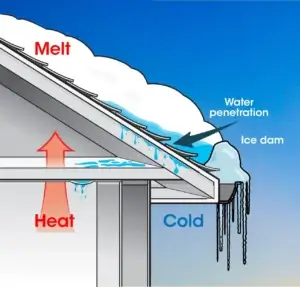Looks can be deceiving. For instance, there are few things as lovely as icicles hanging from roof eaves and gutters. In some regions, they dangle for months, like crystal jewels, sparkling in the sunshine. And yet, in many cases, they signal that the roof may have a problem with ice dam buildup that needs attention before water seeps into the house.
Ice dams form at eaves and gutters and prevent snow – and ice meltwater from leaving the roof. Ice dams are simply ice buildup that dam water on your roof.
They’re often caused by a temperature imbalance in the attic. As heat rises in the house and makes its way into the attic, the upper portion of the roof may warm faster than the lower portion at the eaves without proper airflow.
If the upper portion becomes warm enough to melt snow (above 32°F) while the lower portion remains below freezing temperatures, snow will melt, flow down the roof, and refreeze before it can flow off the edge.
This can also be compounded by naturally rising ambient temperatures during the day and falling temperatures at night. What results is a dam, which will hold the remaining water, snow, and ice on the roof.

Insufficient or deteriorated attic insulation can allow warm air to move from the heated areas of the house to the attic space.
Properly balanced attic ventilation helps slow snow melting by allowing cold air to enter the attic space, in turn driving out warmer air. This reduction in warm attic air helps decrease the chance of snow melting on the roof.
Almost all roofing materials are designed to shed water. As ice melts and refreezes, it can damage the shingles and other parts of the roof system. When a growing ice dam pushes water back up the roof slope, that water may flow under the roof shingles and penetrate into the roof surface or house below.
That’s why GAF factory-certified roofers will always recommend a layer of strong protection like WeatherWatch® or StormGuard® Leak Barrier. These products help prevent leaks due to water backing up in your gutters, wind-driven rain, and, of course, damaging ice dams. They are self-adhering membranes that seal around fasteners and the edge of the roof, helping to protect the most vulnerable areas of your roof against leaks.
Here are 3 steps you can take to prevent ice damming this winter:
Depending on the size and accessibility of your roof, you can use an extendable snow roof rake to (carefully) pull fresh snow off the roof before the melt-and-freeze cycle even begins. Snow and ice removal can be dangerous work and if done improperly you might risk injury to your shingles – or more importantly – yourself! We strongly encourage you to engage the services of a professional to assist with snow rakes and ice dam removal.
Ensure you have a properly-balanced attic ventilation system that allows fresh air to continuously move through the attic space under your roof. To find out how much ventilation you should have, use our ventilation calculator.
Proper attic insulation will do more than prevent ice dams; it can also help reduce your heating costs by keeping warm air in your living space, where it belongs.
Contact us if you have any additional questions about what causes ice dams or if you need assistance with any ice dam removal. We always offer free roof inspections with every visit.
Read our reviews to learn more about us.